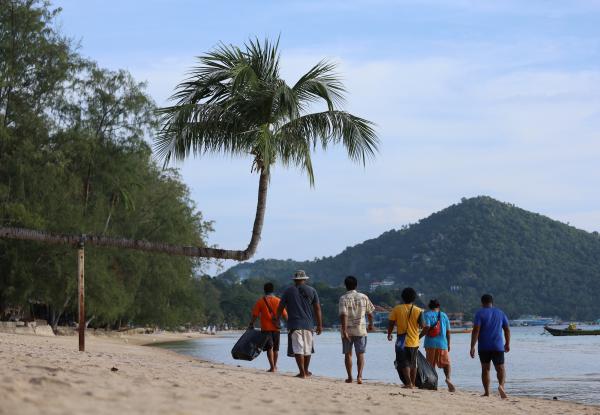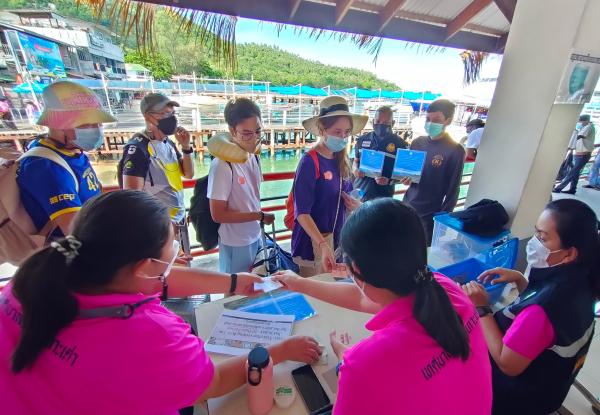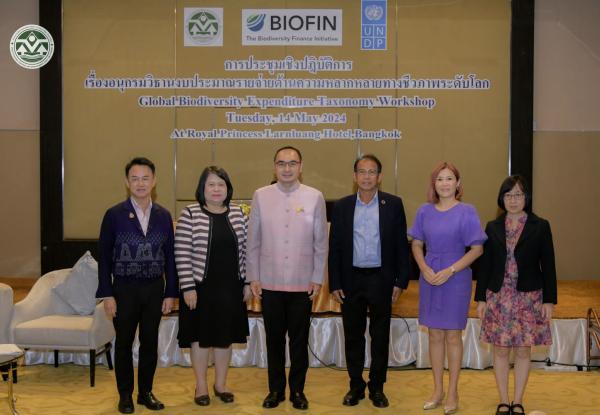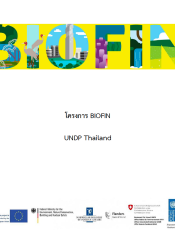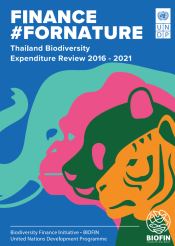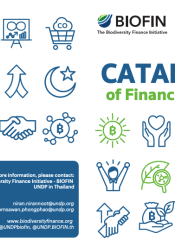Thailand
Located in tropical Southeast Asia, Thailand has land area of 513,120 square kilometers with a population of 69 million. As an upper-middle income economy, Thailand is endowed with a rich ecosystem and biodiversity which are important to the livelihoods of local communities and for national development. It is one of the most biodiverse countries in Southeast Asia, and derives large benefits from the ecosystems, landscapes and habitats that support its unique biodiversity. 9% of all species currently known are found in the country. Thailand has approximately 15,000 plant species, around 8% of the global total; 302 mammal species; over 980 bird species; 320 reptile species; and 120 amphibians. In terms of Thailand’s impressive aquatic biodiversity: there are over 11,900 marine invertebrate species and approximately 2,100 marine fish species and 720 freshwater fish, accounting for 10 % of the estimated total fish species worldwide. The country’s coral reefs also retain important diversity. There is the important environmental role performed by watersheds, river basins and coastal areas, as well as their significance in supporting livelihoods linked to fisheries, recreation and tourism. Similarly, Thailand’s historically vast forest coverage has had substantial effects on the sustenance of agriculture and in fulfilling water and power needs. Thailand had 163,974.52 square kilometres of forest areas, covering 31.68% of the total land area, including national parks, wildlife sanctuaries and other conservation reserve areas. Concerning marine protected areas, Thailand has adopted the target of 10% of coastal and marine areas to be protected. The total coastal and marine protected area is about 18,000 sq.km., accounting for 5.6% of Thai waters. However, Thailand is the country sixth most impacted by climate change in the past 20 years. Recent historic droughts and subsequent severe floods are reminders of this. Forecasts predict that more than 30% of Bangkok may routinely flood as soon as 2030 as the Gulf of Thailand rises due to melting sea ice, while rice production in the Chao Phraya basin risks falling sharply within the next 15 years due to climate change. At the same time, current unsustainable practices, impacts of climate change and biodiversity loss threatens nature’s capacity to contribute to Thailand’s economic growth and wellbeing. The recent global health crisis of COVID-19 is a dramatic reminder of the importance of Nature.
Yet efforts to protect nature face a finance gap of US$1,116 million in order to achieve the National Biodiversity Strategic and Action Plan for Thailand from 2019 to 2021. UNDP found that the financial resources required for satisfying Thailand's biodiversity conservation priorities are double the current annual level of funding for biodiversity in the country.
Against this backdrop, biodiversity finance has been introduced into mainstream policymaking, as investing in the biodiversity and the preservation of ecosystems will provide the foundation for the country’s progress towards achieving the National agenda on Bio-Circular-Green (BCG) economic model and the Global Biodiversity Framework going forward.
BIOFIN started in Thailand in June 2014. This global initiative offers a comprehensive framework for biodiversity finance results: revenue generation, better delivery, expenditure realignment, avoidance of future expenditures, and catalysts.
The Biodiversity Finance Plan for Thailand outlines a diverse set of actions which would help to significantly improve the management and financing of biodiversity conservation in Thailand by fostering cooperation between relevant agencies, stakeholders, the private sector, and wider society to scale up action on nature.
Thailand sets its strong determination to respond to the climate and biodiversity crises in an inclusive manner with political commitment. Thus, the financial resources to nature are being mobilised to support a systemic change in our entire relationship with nature. A sustainable, green economic recovery model could
As stated in the 2021 Thailand Voluntary National Review on Sustainable Development Goal, the government has officially reaffirmed that the BIOFIN is supporting Thailand to close the gap to finance the SDGs, particularly SDG 14 -life below water and SDG 15- live on land. The Plan creates many opportunities across key sectors of the economy – including tourism – particularly by taking full advantage of the Bio-Circular-Green economic potential. The ambitious Plan ensures that it is well placed to meet the spirit of ‘leaving no one behind’.
By implementing this Plan, Thailand achieves the key results of nature-positive finance and investment.
- Increased investment in biodiversity conservation and promotion of its sustainable use in order to achieve national biodiversity targets.
- Increased participation of the private sector and civil society in biodiversity conservation and management in the country.
- Improving government biodiversity budget allocation and cost- effectiveness.
- Moving from a sector-based approach to a results-based budgeting approach.
Under BIOFIN Phase II, Thailand currently focuses on 6 different finance solutions under 4 thematic areas. An increased engagement by the finance sector through a broad-based awareness raising of COVID-19 recovery finance solution has helped the country to mobilise resources for biodiversity management.
UNDP’s BIOFIN Thailand, in close collaboration with the Royal Thai Government, private sector, civil society organization and local communities, has committed to pilot the first set of finance solutions for the period 2019 – 2024. The prioritized biodiversity finance solutions in the Plan are complementary and promote a combination of systemic and local sustainable financing, policy changes, and other incentive mechanisms within 4 thematic areas of intervention. The finance solutions can be summarized as follows:
- Sustainable Tourism Finance Solutions - Increasing sources of revenue for safeguarding biodiversity and environmental management in Koh Tao. (Gender Marker 2) (finance potential US$1 - 1.5 million per year). This solution aims to implement a user charge on the visitors of Koh Tao island. Two main objectives of this finance solution: i) collection of a user charge from tourists either upon arrival or departure and ii) use of the user charge in safeguarding biodiversity and for other environmental conservation purposes. The activities will be implemented in cooperation with local government unit, communities, and civil society.
- Wildlife and Protected Areas Finance Solution - Deployment of conservation vehicle license plates to support wildlife conservation in Thailand (finance potential in US$ 11 million). This finance solution advocates for the introduction of a mechanism mobilizing funds via the introduction of Conservation Vehicle License Plate to collect voluntary payments from vehicle owners in Thailand. Conservation license plates could generate significant revenues as it targets a market of high demand. It provides an easy channel for people to support the environment, through products which they are already using. There is a growing demand for individualized products in Thailand, and willingness to pay among consumers.
- Government Budget Finance Solution - Enhancing effectiveness and biodiversity impact of local budgets in Thailand (Gender marker 2). This finance solution aims to consolidate and amend policy guidelines in order to enable local administration organizations to incorporate biodiversity considerations into the planning of their activities more effectively, particularly at the fiscal budget preparation stage. Overall, the successful adoption of such guidelines will enable LAOs to produce more sound budget justifications, utilizing local budget to increase the biodiversity impact and to achieve the Bio-Circular-Green (BCG) economic model.
- Private Sector Finance Solution - Public Private Partnerships in Sustainable Mangrove Management in Phetchaburi. This finance solution is aimed at providing the evidence and technical backstop to support the development of the first of its kind ‘biodiversity finance plan for sustainable mangrove management at provincial level’, particularly in Phetchaburi province of Thailand. The focus of the work is to conduct technical analysis based on BIOFIN methodology and gather evidence to support BIOFIN Thailand in order to persuade the government, prospective investors, and stakeholders on the opportunity of implementing the Plan and investing in biodiversity preservation.
-
Private Sector Finance Solution: A Platform to Scale Impact Investment Opportunities in Biodiversity. This finance solution is to build a stronger ecosystem for biodiversity impact investment in Thailand. It will support the development of a platform bringing together enterprises promoting biodiversity and impact investors, providing them with the skills and financial instruments/products (in the BIOFIN catalogue) that harnesses the role of impact and blended finance approaches in Thailand. BIOFIN will develop these impact enterprises, including biodiversity sectors such as sustainable fisheries, food waste management and circular economy into biodiversity investment cases that can be used by potential investors who have demonstrated interest in biodiversity-based investments.
-
Crowdfunding ‘Koh Tao, Better Together” - Green recovery during COVID-19 crisis
The purpose of the integrated Policy and Institutional Review (PIR) report is to provide an overview of the policy and institutional context that concerns the management and utilization of Thailand’s biodiversity resources. The report is structured around four main ecosystems in Thailand, namely, terrestrial ecosystem, wetland ecosystem, coastal and marine ecosystem, and urban biodiversity. The specific policies and legal contexts with economic implications that drive both positive and negative trends in biodiversity and ecosystems in the country have been identified. The final Section summarizes preliminary policy recommendations and possible biodiversity finance solutions that will guide Thailand to further its Biodiversity Finance Plan.
This report summarizes current findings from the budget expenditure review that was conducted as part of BIOFIN’s overall assessment of Thailand’s current biodiversity policy environment and investment status. BIOFIN’s conceptual model views the integration of biodiversity investment and resource mobilization into public and private decision making and financing, as being based on a three-part process: 1) A review of current policy practice, biodiversity and ecosystem trends, relevant actors and current expenditures (Policy and Institutional Review in Workbook 1A, 1B and Expenditure Review in Workbook 1C); 2) Costing for the implementation of national biodiversity strategies and actions (Workbook 2); and 3) Identification of potential finance actors, mechanisms, revenue and feasibility (Workbook 3). The process evolves around national biodiversity strategies and action plans that aim to synthesize the root causes of biodiversity and ecosystem pressures, generate public awareness, and identify potential drivers of changes and financing solutions. The resource mobilization plans aim to achieve a better investment state by generating sufficient public and private responses in order to close the biodiversity financing gap.
The purpose of this report is to present the preliminary estimates of financing needs for biodiversity conservation for Thailand. The results are based on three sources of information namely (i) National Biodiversity Strategic Action Plans (NBSAP) (ii) the budget estimate of MONRE and (iii) BIOFIN Thailand estimates of financing needs for coastal and marine ecosystems. It has been the intention of BIOFIN Thailand that more in-depth estimates for financing needs for terrestrial and inland wetland ecosystems similar to the details for coastal and marine ecosystems. This would, however, require additional time to collaborate with the line agencies responsible for these ecosystems, namely the Department of National Park Wildlife and Plants (DNP), the Royal Forestry Department (RFD) and the Office of Natural Environmental Policy and Planning (ONEP). It was thus decided that, parallel to the work undertaken on the pilot studies, we will be continuing with the work on costing selected measures for terrestrial and inland wetland ecosystems with the aim that by the end of 2018, we will have clearer ideas of measures required to improve the two ecosystem. Until these are available and accessible, the estimates in this report should be considered as the lower bound estimates of what will be required. Moreover the figures on overall financing needs have been revised and slightly differ from the sum reported in the BIOFIN Regional Workshop in Kazakhstan in April and this is due to different time period for cost estimates of coral reefs and seagrass restoration.
